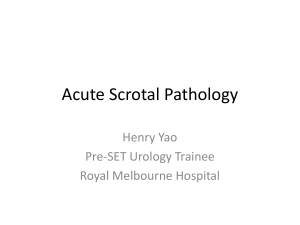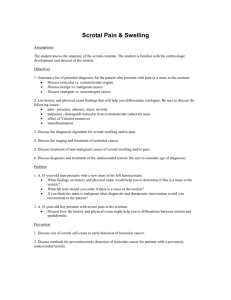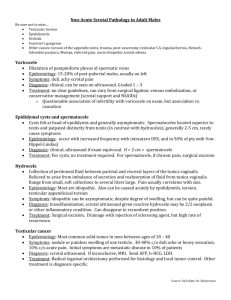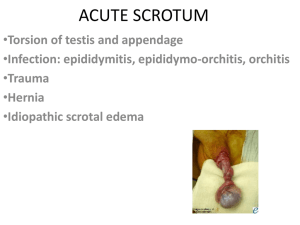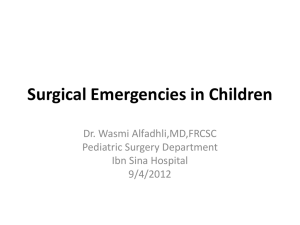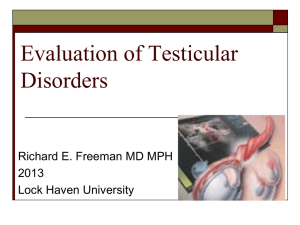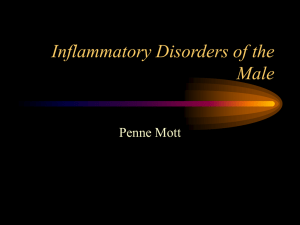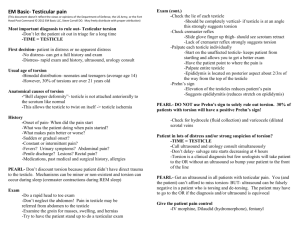A twist and a turn - Rhode Island Medical Society
advertisement
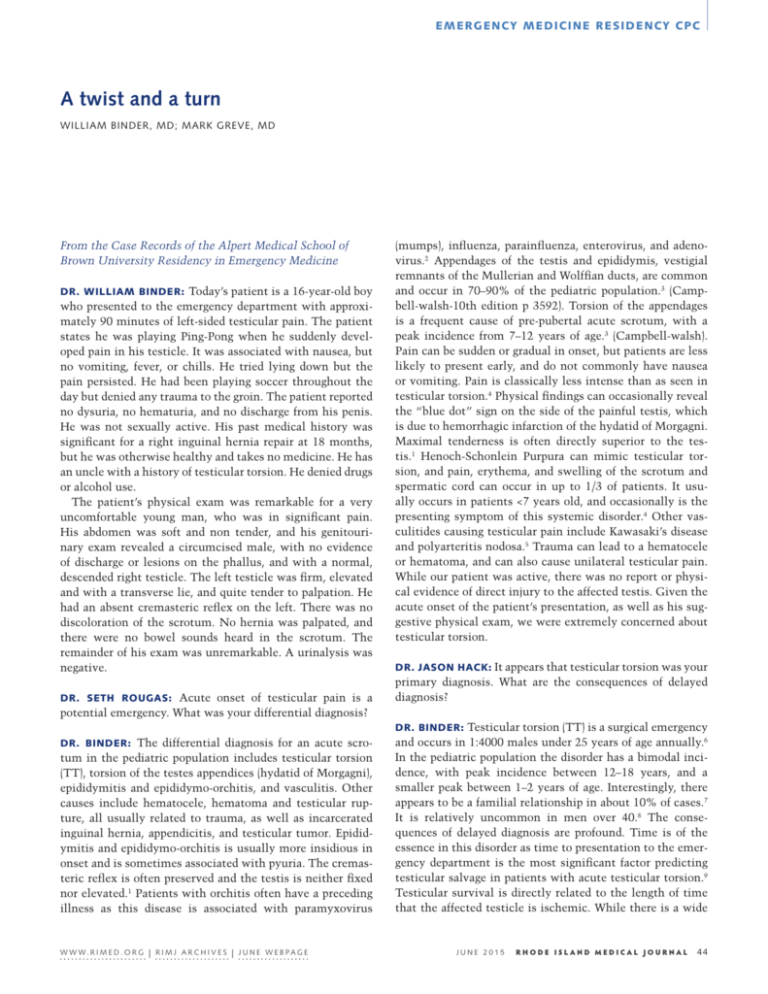
EMERGENC Y MED IC INE RESID EN CY CPC A twist and a turn WILLIAM BINDER, MD; MARK GREVE, MD From the Case Records of the Alpert Medical School of Brown University Residency in Emergency Medicine DR. WILLIAM BINDER: Today’s patient is a 16-year-old boy who presented to the emergency department with approximately 90 minutes of left-sided testicular pain. The patient states he was playing Ping-Pong when he suddenly developed pain in his testicle. It was associated with nausea, but no vomiting, fever, or chills. He tried lying down but the pain persisted. He had been playing soccer throughout the day but denied any trauma to the groin. The patient reported no dysuria, no hematuria, and no discharge from his penis. He was not sexually active. His past medical history was significant for a right inguinal hernia repair at 18 months, but he was otherwise healthy and takes no medicine. He has an uncle with a history of testicular torsion. He denied drugs or alcohol use. The patient’s physical exam was remarkable for a very uncomfortable young man, who was in significant pain. His abdomen was soft and non tender, and his genitourinary exam revealed a circumcised male, with no evidence of discharge or lesions on the phallus, and with a normal, descended right testicle. The left testicle was firm, elevated and with a transverse lie, and quite tender to palpation. He had an absent cremasteric reflex on the left. There was no discoloration of the scrotum. No hernia was palpated, and there were no bowel sounds heard in the scrotum. The remainder of his exam was unremarkable. A urinalysis was negative. DR. SETH ROUGAS: Acute onset of testicular pain is a (mumps), influenza, parainfluenza, enterovirus, and adenovirus.2 Appendages of the testis and epididymis, vestigial remnants of the Mullerian and Wolffian ducts, are common and occur in 70–90% of the pediatric population.3 (Campbell-walsh-10th edition p 3592). Torsion of the appendages is a frequent cause of pre-pubertal acute scrotum, with a peak incidence from 7–12 years of age.3 (Campbell-walsh). Pain can be sudden or gradual in onset, but patients are less likely to present early, and do not commonly have nausea or vomiting. Pain is classically less intense than as seen in testicular torsion.4 Physical findings can occasionally reveal the “blue dot” sign on the side of the painful testis, which is due to hemorrhagic infarction of the hydatid of Morgagni. Maximal tenderness is often directly superior to the testis.1 Henoch-Schonlein Purpura can mimic testicular torsion, and pain, erythema, and swelling of the scrotum and spermatic cord can occur in up to 1/3 of patients. It usually occurs in patients <7 years old, and occasionally is the presenting symptom of this systemic disorder.4 Other vasculitides causing testicular pain include Kawasaki’s disease and polyarteritis nodosa.5 Trauma can lead to a hematocele or hematoma, and can also cause unilateral testicular pain. While our patient was active, there was no report or physical evidence of direct injury to the affected testis. Given the acute onset of the patient’s presentation, as well as his suggestive physical exam, we were extremely concerned about testicular torsion. DR. JASON HACK: It appears that testicular torsion was your primary diagnosis. What are the consequences of delayed diagnosis? potential emergency. What was your differential diagnosis? DR. BINDER: Testicular torsion (TT) is a surgical emergency DR. BINDER: The differential diagnosis for an acute scro- tum in the pediatric population includes testicular torsion (TT), torsion of the testes appendices (hydatid of Morgagni), epididymitis and epididymo-orchitis, and vasculitis. Other causes include hematocele, hematoma and testicular rupture, all usually related to trauma, as well as incarcerated inguinal hernia, appendicitis, and testicular tumor. Epididymitis and epididymo-orchitis is usually more insidious in onset and is sometimes associated with pyuria. The cremasteric reflex is often preserved and the testis is neither fixed nor elevated.1 Patients with orchitis often have a preceding illness as this disease is associated with paramyxovirus W W W. R I M E D . O R G | RIMJ ARCHIVES | J U N E W E B PA G E and occurs in 1:4000 males under 25 years of age annually.6 In the pediatric population the disorder has a bimodal incidence, with peak incidence between 12–18 years, and a smaller peak between 1–2 years of age. Interestingly, there appears to be a familial relationship in about 10% of cases.7 It is relatively uncommon in men over 40.8 The consequences of delayed diagnosis are profound. Time is of the essence in this disorder as time to presentation to the emergency department is the most significant factor predicting testicular salvage in patients with acute testicular torsion.9 Testicular survival is directly related to the length of time that the affected testicle is ischemic. While there is a wide JUNE 2015 RHODE ISLAND MEDICAL JOURNAL 44 EMERGENC Y MED IC INE RESID EN CY CPC range of times reported, most testis are salvageable if perfusion is restored less than 6 hours after onset of pain.10,11 Testicular salvage is approximately 20–50% after 10–12 hours of onset of pain, while viability is almost negligible after 24 hours.12,13,14 Delay in diagnosis has medicolegal repercussions, as well. In the United States, England and Canada, testicular torsion is a common complaint resulting in successful plaintiff litigation.10 Ischemia and reperfusion injury may have an impact on fertility. Several studies have reported abnormal sperm count, motility and morphology in torsion patients as compared to normal controls.10 Additionally, levels of anti-sperm antibody were abnormal in patients with testicular torsion, but this was not statistically different from controls.15 Reperfusion injury can cause reactive oxygen free radicals, a proinflammatory cytokine response, lipid peroxidation, and alterations in microvascular blood flow, potentially leading to decreased hormone production and diminished fertility.12 visualization.19 The “whirlpool” sign, a spiral twist of the spermatic cord, is noted on HRUS.10 Other imaging modalities include spatially resolved near-infrared spectroscopy (SR-NIRS). NIRS is a non-invasive optical technique which measures local oxygenated and deoxygenated hemoglobin and tissue oxygen saturation via a bedside handheld device.20 Radionuclide imaging and MRI are both time consuming and are infrequently used. Surgical exploration is the gold standard in this disorder and if imaging is not available or does not provide clinical concordance, surgical intervention is essential. Our patient had a normal color doppler ultrasound but a history and exam quite suggestive of TT. A urologist saw the patient and made plans for a bilateral orchidopexy the following morning. In the operating room the patient was found to have a pink and viable left testicle, but continued to have 180 degrees of torsion on the left side. The spermatic cord was completely detorsed, an orchidopexy was performed bilaterally, and the patient did well and had no sequelae. DR. JOHN SCHIMMEL: The patient presented with acute and severe pain. How did you manage the patient and what were your diagnostic options? FINAL DIAGNOSIS: Testicular torsion (partial). DR. MARK GREVE: Based on the history and physical exam, References the patient was clinically suspect for torsion of the left testis and manual detorsion was immediately performed as both a diagnostic and therapeutic maneuver. The patient had significantly decreased pain after 2 rotations of the affected testicle in a medial to lateral rotation. Within 10 minutes he complained of only soreness to the affected side. Manual detorsion is performed by reversing the initial twisting of the torsed testicle; 2/3 of the time this is a lateral to medial rotation of the spermatic vessels.16 The left testicle is held between the right thumb and index finger and rotated away from the midline, as if opening a book.17 Simultaneously, the testicle should also be rotated in a caudal to cranial direction. Resistance or increased pain suggests that the torsion was medial to lateral and detorsion should be accomplished in the opposite direction.13 The classic teaching is to rotate until there is relief, and the median for degree of rotation in orchiectomy cases is 3 rotations or 540°.16 Immediately after detorsion we obtained an ultrasound of the testicle and requested a urology consultation. High-resolution ultrasonography (HRUS) and color doppler ultrasonography (CDS) are the primary imaging modalities for the evaluation of the acute scrotum. In TT, venous and arterial blood flow is reduced on ultrasound, depending on the degree of torsion. Conversely, flow is increased in epididymitis and epididymo-orchitis, distinguishing it quite clearly from torsion. Additionally, about 1–3 hours after onset of pain, the testicle enlarges and ultrasound commonly reveals increased heterogenous echogenicity.18 Clinicians should verify that sonographic imaging includes the spermatic cord. In a series of 919 patients this combined modality had a sensitivity of 96% versus a sensitivity of 76% without cord W W W. R I M E D . O R G | RIMJ ARCHIVES | J U N E W E B PA G E 1. Gunther P, Rubben I. The Acute Scrotum in Childhood and Adolescence. Deutsches Arzteblatt International. 2012; 109: 449 – 458. 2. Gatti JM, Murphy JP. Acute Testicular Disorders. Pediatrics in Review. 2008; 29: 235-241. 3. Barthold JS. Abnormalities of the Testis and Scrotum and their Surgical Management. In Wein AJ, Kavoussi LR, Novick AC, Partin AW, Peters CA, ed. Campbell-Walsh Urology. Philadelphia, PA: Elsevier; 2012: 3557-3596. 4. Vasdev N, Chadwick D, Tomas D. The acute pediatric scrotum: presentation, differential diagnosis, and management. Current Urology. 2012; 6 : 57-61. 5. Gervaise A, Junca-Laplace C, Naulet P, Pemin M, Portron Y, Lapierre-Combes M. Unilateral testicular vasculitis in polyarteritis nodosa mimicking a testicular torsion. Diagnostic and Interventional Imaging. 2014; 95: 615-616. 6. Amato R, Legrad G, Pocard M. Management of testicular torsion. Journal of Visceral Surgery. 2014; 151: 307 – 309. 7. Cubilios J, Palmer JS, Friedman SC, Freyle J, Lowe FC, Palmer LS. Journal of Urology. 2011; 185 supplement: 2469 -2473. 8. Kessler CS, Baum J. Non-traumatic Urologic Emergencies in Men: A clinical review. Western Journal of Emergency Medicine. 2009; 10: 281-287. 9. Ramachandra P, Palazzi KL, Holmes NM, Marietti S. Factors Influencing Rate of Testicular Salvage in Acute Testicular Torsion at a Tertiary Pediatric Center. Western Journal of Emergency Medicine. 2015; 16: 190 – 193. 10.DaJusta DG, Granberg CF, Villanueva C, Baker LA. Contemporary Review of Testicular Torsion: New Concepts, emerging technologies and potential therapeutics. Journal of Pediatric Urology. 2013; 9: 723-730. 11.Kallerhoff M, Gross AK, Botefur JC. The influence of termperature on changes in pH, lactate and morphology during testicular ischaemia. The British Journal of Urology. 1996; 78: 440 – 445. 12.Karaguzel E, Kadihasanoglu, M, Kutlu O. Mechanism of testicular torsion and potential protective agents. Nature Reviews Urology. 2014; 11: 391-399. 13.Harvey M, Ghanwai G, Cave G. Manual Testicular Detorsion JUNE 2015 RHODE ISLAND MEDICAL JOURNAL 45 EMERGENC Y MED IC INE RESID EN CY CPC under Propofol Sedation. Case Reports in Medicine. 2009; 2009: 529346. 14.Osman S, Zaidi SF, Lehnert BE, Linnau KF. Core curriculum illustration: testicular torsion. Emergency Radiology: 2014; 21: 321 – 323. 15.Arap MA, Vicentini FC, Cocuzza M, Hallak J, Athayde K, Lucon AM, et al. Late hormonal levels, semen parameters, and presence of antisperm antibodies in patients treated for testicular torsion. International Journal of Andrology. 2007; 28: 528 -532. 16.Sessions AE, Rabinowitz R, Hulbert WC, et al. Testicular Torsion: Direction, Degree, Duration and Disinformation. Journal of Urology. 2003;169: 663- 665. 17.Ringdahl E, Teague L. Testicular torsion. American Family Physician. 2006; 74: 1739-1743. 18.D’Andrea A, Coppolino F, Cesarano E, Russo A, et al. Ultrasound in the assessment of the acute scrotum. Critical Ultrasound Journal. 2013; Supplement 1: 58 -63. 19.Kalfa N, Veyrac C, Lopez M, et al. Multicenter assessment of ultra- sound of the spermatic cord in children with acute scrotum. Journal of Urology. 2007;177:297-301. 20.Shadgan B, Fareghi M, Strothers L, Macnab A, Kajbafzadeh AM. Diagnosis of testicular torsion using near infrared spectroscopy: A novel diagnostic approach. Canadian Urology Association Journal. 2014; 8: 249-252. W W W. R I M E D . O R G | RIMJ ARCHIVES | J U N E W E B PA G E Authors William Binder, MD, Assistant Professor of Emergency Medicine, Alpert Medical School, Brown University. Mark Greve, MD, Assistant Professor of Emergency Medicine, Alpert Medical School, Brown University. Correspondence William Binder, MD William_Binder@brown.edu JUNE 2015 RHODE ISLAND MEDICAL JOURNAL 46
